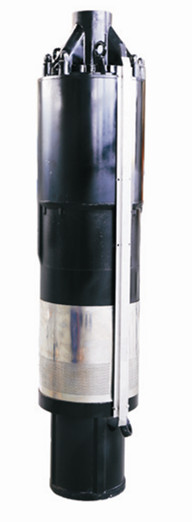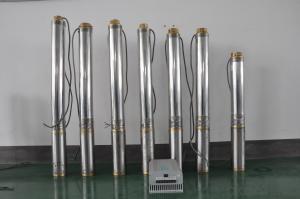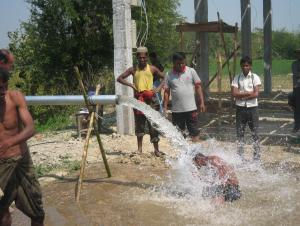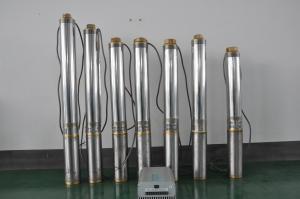Solar Water Pump 3DS-14
- Loading Port:
- China Main Port
- Payment Terms:
- TT OR LC
- Min Order Qty:
- -
- Supply Capability:
- 300 sets /month
OKorder Service Pledge
OKorder Financial Service
You Might Also Like
Product description:
Product: Solar water pump
Model:3DS-14

Appilication:
submersible pump
for deep well or pond or lake
for irrigation of a big farm with 12000 m2
Product specification:
flow rate:20m3/ hour, 160m3/day.
lift: 10m-50m
pump diameter: 296mm
well diameter more than 310mm
with BLDC motor, motor power:4000W
but only need solar power:2200W, our pump can save more than 50% solar panel power.
Material:
Pump inside: stainless steel and wearable nylon,it enables our solar pump to have 10 years sevice life.
Motor length:30cm,80% shorter than other motors. So that you can pump 80% more water by our solar pump.
Certification:
3 International patent
ISO9001
CE
Warranty:2 years
- Q:How does the performance of a solar pump vary with different solar panel angles?
- The performance of a solar pump can vary with different solar panel angles. The optimal angle for the solar panels depends on the geographical location and the time of year. Generally, aligning the solar panels perpendicular to the sun's rays maximizes the energy conversion and thus enhances the pump's performance. However, if the angle is too steep or too shallow, the amount of sunlight reaching the panels decreases, resulting in lower energy production and reduced pump efficiency. Therefore, finding the ideal angle that captures the most sunlight throughout the day is crucial for optimizing the performance of a solar pump.
- Q:Are there any limitations to the type of control system that can be used with a solar pump?
- Yes, there are limitations to the type of control system that can be used with a solar pump. One limitation is the availability of sunlight. Solar pumps rely on solar panels to generate electricity, so if there is insufficient sunlight, the pump may not work optimally or at all. Additionally, the size and capacity of the solar panels also impact the pump's performance. Other limitations include the need for proper installation and maintenance, as well as the compatibility of the control system with the specific solar pump model. Overall, while solar pumps offer sustainable and efficient water pumping solutions, their control systems are subject to certain limitations.
- Q:Can a solar pump be used for water supply in off-grid schools?
- Yes, a solar pump can be used for water supply in off-grid schools. Solar pumps are an excellent option for off-grid locations, as they rely on solar energy to power the pump, eliminating the need for grid electricity. This makes them a sustainable and cost-effective solution for water supply in areas where electricity is not readily available. Solar pumps can be used to extract water from wells, boreholes, or other water sources, and they can deliver water to storage tanks or directly to the school's water distribution system. They are particularly suitable for off-grid schools as they can operate independently without the need for complex and expensive infrastructure. Solar pumps are also environmentally friendly, as they do not require any fuel or produce any greenhouse gas emissions during operation. They are low-maintenance and have a long lifespan, making them a reliable and sustainable solution for water supply in off-grid schools. Furthermore, solar pumps can be equipped with battery storage systems, allowing them to operate even during cloudy days or at night. This ensures a continuous water supply to the school, regardless of weather conditions or time of day. In conclusion, solar pumps are a viable and efficient option for water supply in off-grid schools. They offer a sustainable, cost-effective, and reliable solution, ensuring access to clean water for students and staff in remote areas.
- Q:How long does it take for a solar pump to pay for itself through energy savings?
- The payback period for a solar pump can vary depending on several factors such as the cost of the pump, the amount of energy savings achieved, and the local energy rates. On average, a solar pump can pay for itself in 3 to 7 years through energy savings. Solar pumps are an energy-efficient alternative to traditional pumps that rely on fossil fuels or grid electricity. They utilize solar panels to convert sunlight into electricity, eliminating the need for ongoing fuel costs or grid electricity consumption. This results in significant energy savings over time. To calculate the payback period for a solar pump, it is necessary to consider the initial investment cost and the ongoing energy savings. The initial cost typically includes the price of the pump itself, installation, and any additional components such as solar panels and batteries. Energy savings are determined by comparing the pump's energy consumption to that of a traditional pump. Once the initial investment cost and energy savings are determined, the payback period can be calculated by dividing the initial cost by the annual energy savings. For example, if the initial cost is $10,000 and the annual energy savings amount to $2,000, the payback period would be 5 years ($10,000/$2,000). It is important to note that the payback period can be influenced by various factors. These include the geographical location, the size and efficiency of the solar pump system, the amount of sunlight available, and the specific energy rates in the area. Additionally, any government incentives or grants for solar installations can significantly reduce the payback period. Overall, investing in a solar pump can provide long-term financial benefits through energy savings. While the payback period may vary, the environmental benefits and reduced reliance on non-renewable energy sources make solar pumps a sustainable and cost-effective choice in the long run.
- Q:Can solar pumps be used for water supply in mining or quarrying operations?
- Yes, solar pumps can be used for water supply in mining or quarrying operations. Solar pumps are a sustainable and environmentally-friendly alternative to traditional diesel or electric pumps. They can provide a reliable source of water for various mining and quarrying activities, including dust suppression, ore processing, and general site maintenance. Additionally, solar pumps offer cost savings in the long run as they rely on renewable energy and require minimal maintenance.
- Q:The problem of installing pressurized water pump in solar hot water outlet pipe
- in order to facilitate the maintenance and the use of safety, in the pump inlet and outlet of the pipeline to install a control valve and pump near the installation of a pressure gauge to ensure that the rated head and flow within the operation to ensure that the pump normal operation, Pump life.
- Q:Are there any restrictions on using a solar pump in agriculture?
- Yes, there can be certain restrictions on using a solar pump in agriculture. Some potential limitations include the availability of sunlight, which can affect the efficiency of the pump, especially in regions with frequent cloudy or rainy weather. Additionally, the initial cost of installing a solar pump can be higher compared to traditional pumps, which may pose financial constraints for some farmers. It is also important to consider the size and capacity of the solar pump, as it may not be suitable for large-scale irrigation needs.
- Q:Are solar pumps suitable for both residential and commercial use?
- Yes, solar pumps are suitable for both residential and commercial use. They are an efficient and environmentally-friendly option for pumping water in various applications, including irrigation, livestock watering, and water supply for residential, commercial, and agricultural purposes. Solar pumps can be easily installed and operated, making them a versatile choice for both small-scale and large-scale water pumping needs.
- Q:Can a solar pump be used in combination with a storage tank?
- Yes, a solar pump can certainly be used in combination with a storage tank. In fact, using a storage tank with a solar pump can be a very effective way to optimize the use of solar energy and ensure a steady supply of water. With a solar pump, the energy from the sun is used to power the pump and move water from a source (such as a well or a river) to a desired location. By connecting the solar pump to a storage tank, the excess water can be stored during periods of ample sunlight and then used when there is less sunlight or higher water demand. The storage tank serves as a reservoir to store the water pumped by the solar pump. This allows for a continuous water supply, even during nighttime or cloudy days when the solar panel may not generate enough energy to power the pump. The water stored in the tank can be used for various purposes, such as irrigation, livestock watering, or even household use. Additionally, using a storage tank in combination with a solar pump can help to minimize the impact of fluctuations in water availability. It provides a buffer, allowing for water to be stored during times of plenty and used during times of scarcity. This can be particularly beneficial in areas with seasonal variations in water availability or unreliable water sources. In conclusion, combining a solar pump with a storage tank is a practical and efficient solution to optimize the use of solar energy and ensure a steady water supply. It allows for water to be stored during periods of ample sunlight and used when there is less sunlight or higher water demand, providing a continuous water supply regardless of fluctuations in solar energy availability.
- Q:How does a solar pump handle water source contamination from textile manufacturing?
- A solar pump alone cannot address water source contamination from textile manufacturing. However, it can be part of a larger solution by providing a sustainable and renewable source of power for water treatment systems that can effectively handle and mitigate contamination issues caused by textile manufacturing.
1. Manufacturer Overview |
|
|---|---|
| Location | |
| Year Established | |
| Annual Output Value | |
| Main Markets | |
| Company Certifications | |
2. Manufacturer Certificates |
|
|---|---|
| a) Certification Name | |
| Range | |
| Reference | |
| Validity Period | |
3. Manufacturer Capability |
|
|---|---|
| a)Trade Capacity | |
| Nearest Port | |
| Export Percentage | |
| No.of Employees in Trade Department | |
| Language Spoken: | |
| b)Factory Information | |
| Factory Size: | |
| No. of Production Lines | |
| Contract Manufacturing | |
| Product Price Range | |
Send your message to us
Solar Water Pump 3DS-14
- Loading Port:
- China Main Port
- Payment Terms:
- TT OR LC
- Min Order Qty:
- -
- Supply Capability:
- 300 sets /month
OKorder Service Pledge
OKorder Financial Service
Similar products
New products
Hot products
Related keywords



























